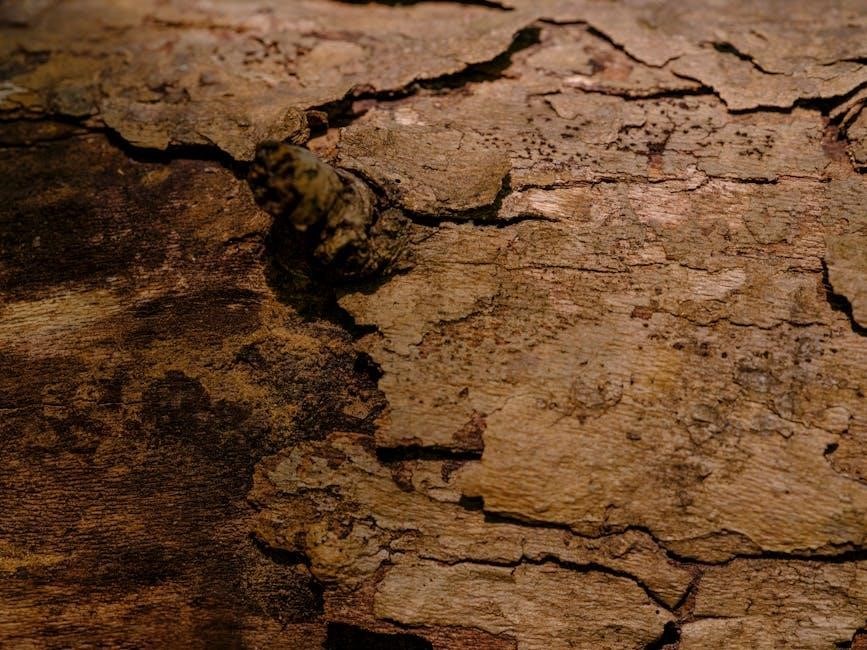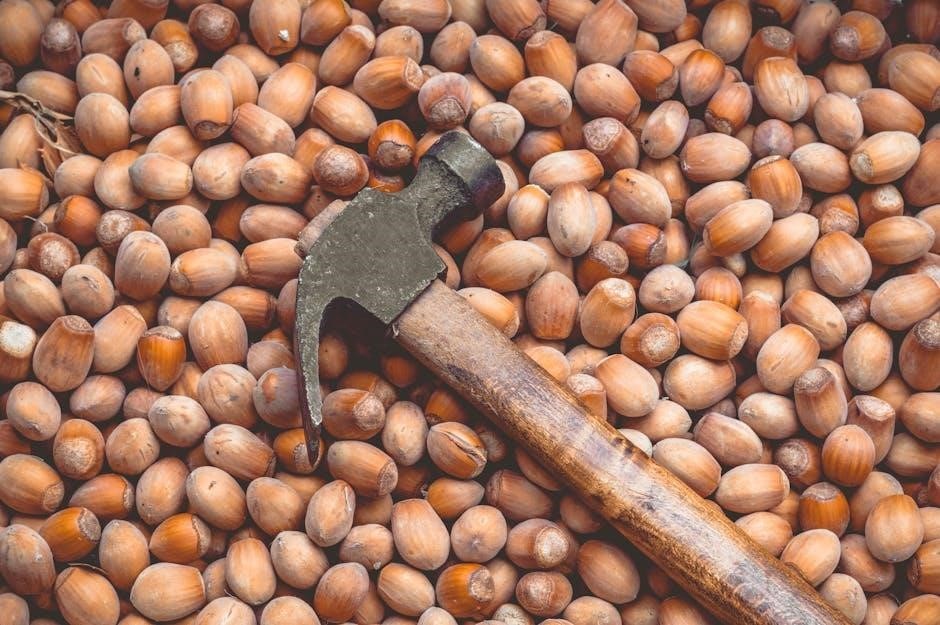The wood hardness chart is a visual guide measuring wood’s resistance to denting and wear, part of the Janka Scale, widely used in flooring and furniture making.
1.1 What is the Wood Hardness Chart?
The Wood Hardness Chart is a comprehensive guide that ranks wood species based on their resistance to denting and wear. It uses the Janka Hardness Scale, which measures the force required to embed a steel ball into wood. This scale helps determine a wood’s durability and suitability for various applications like flooring and furniture making.
The chart categorizes wood species, providing a clear comparison of hardness levels. It is widely used in the woodworking and construction industries to select appropriate materials for projects. The chart is also available as a downloadable PDF for easy reference.
1.2 Importance of Understanding Wood Hardness
Understanding wood hardness is essential for selecting the right wood for various projects; It helps determine a wood’s durability, resistance to wear, and suitability for applications like flooring and furniture making. The Janka Hardness Scale provides a standardized measure of hardness, guiding decisions on which species to use for different purposes. Knowing wood hardness ensures optimal performance, longevity, and maintenance of wood products, making it a critical factor in construction and woodworking projects. Referencing a wood hardness chart simplifies this process, offering clear comparisons and practical insights.

The Janka Hardness Scale
The Janka Hardness Scale measures wood’s resistance to denting and wear, providing a standardized method to compare species. Higher ratings indicate harder, more durable woods.
2.1 What is the Janka Hardness Scale?
The Janka Hardness Scale is a widely recognized method for determining wood’s resistance to denting and wear. It measures the force required to embed an 11.28mm steel ball halfway into a wood sample. Higher ratings indicate harder, more durable woods. This scale is essential for comparing species and predicting performance in flooring, furniture, and construction. It provides a standardized reference for woodworkers and consumers to evaluate suitability for various applications.
2.2 Common Domestic Species Janka Ratings
Domestic wood species are ranked on the Janka Hardness Scale based on their resistance to wear. Hickory is among the hardest, with a rating of 1,820 lbf, while softer options like aspen (350 lbf) and eastern white pine (380 lbf) are more prone to denting. Other common domestic species include maple (950 lbf), oak (1,290 lbf), and cherry (995 lbf). These ratings help consumers and professionals select appropriate woods for flooring, furniture, and construction projects, balancing durability and aesthetic preferences. Higher ratings indicate greater hardness and resistance to impact.

The Janka Hardness Test Process
The Janka hardness test measures resistance to denting by embedding an 11.28mm steel ball into the wood until it reaches half its diameter, quantifying hardness and durability.
3.1 How the Janka Test is Conducted
The Janka test involves embedding an 11.28mm steel ball into wood until it reaches half its diameter. The force required is measured in pounds-force (lbf), reflecting the wood’s resistance to denting and wear. This standardized method ensures consistent results, providing a reliable comparison of wood species’ hardness. The test is typically performed on the wood’s face grain, as edge grain measurements are not included in the final rating. Higher values indicate harder, more durable wood, crucial for applications like flooring and furniture.
3.2 Measuring Resistance to Denting and Wear
The Janka hardness test quantifies a wood’s ability to resist surface damage by measuring the force needed to embed a steel ball halfway into its surface. This process evaluates both denting and wear resistance, providing insights into the wood’s durability for various applications. The results are expressed in pounds-force (lbf), with higher values indicating greater resistance. This measurement is crucial for assessing suitability for flooring, furniture, and construction, where withstanding daily wear is essential. The test specifically focuses on the wood’s face grain, offering a clear comparison of species’ performance.

Understanding Wood Hardness Ratings
Wood hardness ratings, based on the Janka scale, measure resistance to denting and wear, helping determine suitability for flooring, furniture, and construction projects.
4.1 Softest Woods on the Chart
The softest woods on the Janka chart include species like Balsa (67 lbf), Paulownia (300 lbf), and Monkey Puzzle (320 lbf). These woods are often used in lightweight applications due to their low density and flexibility. For instance, Balsa is popular in model-making and musical instruments, while Paulownia is valued for its lightweight yet durable properties. These softer woods are ideal for projects requiring minimal weight without compromising on unique aesthetic appeal.
4.2 Hardest Woods on the Chart
The hardest woods on the Janka chart, like Ipe (3680 lbf) and Australian Buloke (3540 lbf), are highly durable and resistant to wear. These species are often used for high-traffic flooring and heavy-duty applications due to their exceptional strength. Their dense cellular structure makes them less prone to denting and damage, ensuring longevity. Such woods are ideal for projects requiring maximum resilience, such as commercial flooring or outdoor construction, where durability is a top priority.

Applications of the Wood Hardness Chart
The wood hardness chart is a critical guide for selecting wood based on hardness, ideal for flooring, furniture making, and construction projects requiring durable materials.
5.1 Flooring Selection
When selecting wood for flooring, the wood hardness chart is essential. It helps determine a species’ durability, resistance to wear, and ability to withstand foot traffic. Harder woods, like hickory or maple, are ideal for high-traffic areas, while softer woods, such as pine or fir, may be better suited for low-traffic spaces. The chart provides a clear ranking, guiding homeowners and professionals in choosing the most suitable option for their needs, ensuring long-lasting performance and aesthetic appeal.
5.2 Furniture Making
In furniture making, the wood hardness chart is a crucial tool for selecting the right materials. Hardwoods like oak and maple are preferred for their durability and resistance to wear, making them ideal for high-use pieces. Softer woods, such as pine, are often chosen for their workability and cost-effectiveness but may require additional finishes for protection. The chart helps craftsmen balance aesthetics, strength, and practicality, ensuring their creations are both functional and long-lasting.
5.3 Construction and Engineering
The wood hardness chart plays a key role in construction and engineering by helping professionals choose the right wood species for structural projects. Harder woods, like hickory, are often used in load-bearing applications due to their high strength and resistance to compression. Softer woods, such as spruce, are used where flexibility and ease of shaping are more important. Understanding wood hardness ensures that materials are appropriately matched to their intended use, enhancing the safety and durability of buildings, bridges, and other infrastructure.

Factors Affecting Wood Hardness
Wood hardness is influenced by its grain direction, with vertical grains typically harder than horizontal ones, and moisture content, as higher moisture reduces hardness.
6.1 Grain Direction and Its Impact
Wood hardness varies significantly based on grain direction. The Janka test measures hardness on the wood’s face, not its edges, as vertical grains are generally harder than horizontal ones. This variation is crucial for applications like flooring, where wear resistance depends on grain orientation. For instance, wood with straight, tightly packed grains tends to be harder and more durable than those with irregular or loose grains. Understanding grain direction helps in selecting the right wood for specific uses, ensuring optimal performance and longevity in projects like furniture or construction. Proper alignment enhances resistance to denting and wear.
6.2 Moisture Content and Density
Moisture content and density significantly influence wood hardness. Higher moisture levels soften wood, reducing its resistance to denting and wear. Density, often linked to hardness, varies among species. Dense woods like hickory are harder, while less dense woods like pine are softer. The Janka Scale reflects these variations, providing a relative measure of hardness. Proper kiln-drying ensures stable moisture levels, preserving wood’s natural hardness. Understanding these factors helps in selecting durable materials for flooring and furniture, ensuring long-term performance and aesthetic appeal.

Reading and Interpreting the Chart
The wood hardness chart organizes species alphabetically or by hardness, providing clear ratings to help users understand and compare wood durability for various applications.
7.1 Alphabetical Listing of Wood Species
The chart lists wood species alphabetically, making it easy to locate specific types. Each entry includes the species name and its corresponding Janka hardness rating in pounds-force. This format allows for quick reference and comparison, helping users identify the hardness of various woods efficiently. The alphabetical organization ensures that even lesser-known species are easily accessible, providing a comprehensive guide for professionals and enthusiasts alike to make informed decisions based on wood hardness.
7.2 Categorizing by Hardness Levels
The chart organizes wood species into categories based on their Janka hardness ratings, ranging from the softest to the hardest. This classification helps users quickly identify woods suitable for specific applications. For instance, softer woods like balsa (67 lbf) are grouped separately from harder options like Ipe (3680 lbf). This categorization aids in selecting appropriate materials for projects, ensuring durability and performance based on hardness levels. It also provides a clear visual representation of how woods compare in terms of resistance to denting and wear.

Regional Variations in Wood Hardness
Wood hardness varies geographically, with domestic and exotic species showing differences in density and durability due to climate and growth conditions, impacting their Janka ratings.
8.1 Domestic vs. Exotic Wood Species
Domestic and exotic wood species exhibit distinct hardness levels due to regional growth conditions. Domestic woods like hickory and oak are popular for flooring, offering durability and affordability. Exotic species, such as Brazilian walnut and ipe, often have higher Janka ratings, indicating greater resistance to wear. However, their hardness can vary based on origin and environmental factors, making the wood hardness chart essential for comparing their suitability for various applications.
8.2 International Wood Hardness Standards
International wood hardness standards often align with the Janka Hardness Scale, but variations exist due to regional testing methods. While the Janka Scale is widely adopted, some countries use alternative measures like the Brinell hardness test. These standards ensure consistency in evaluating wood durability for global trade. The wood hardness chart incorporates these variations, providing a comprehensive reference for comparing domestic and exotic species. This harmonization is crucial for manufacturers and designers working with diverse wood types across borders, ensuring compatibility and performance in different environments.

Obtaining the Wood Hardness Chart in PDF
The wood hardness chart PDF is easily downloadable from trusted sources, offering a convenient guide for comparing wood species and planning projects effectively.
9.1 Downloading the Chart for Reference
Downloading the wood hardness chart PDF provides a quick reference for wood species ratings, ideal for contractors and DIYers. It’s easily accessible online, ensuring convenience for project planning. The PDF format allows for offline access, making it a reliable resource for comparing hardness levels and selecting the appropriate wood for flooring, furniture, or construction. Trusted websites like Tiny Timbers offer comprehensive charts, categorized alphabetically or by hardness, ensuring accurate and practical information for various woodworking needs. This resource is essential for anyone seeking to make informed decisions based on wood durability and performance.
9.2 Trusted Sources for the Janka Chart
Reputable sources like Tiny Timbers and Ohio Hardwood Furniture offer accurate Janka hardness charts in PDF formats. These trusted platforms ensure data reliability, providing detailed wood species ratings for flooring and furniture projects. The charts are alphabetically listed or categorized by hardness, making them user-friendly. They are frequently updated and verified, guaranteeing consistency with industry standards. Downloading from these sources ensures access to precise information, essential for professionals and enthusiasts alike seeking reliable wood hardness data for their projects;

Limitations of the Janka Hardness Scale
The Janka Hardness Scale has limitations, as it doesn’t account for environmental factors or testing conditions, which can affect wood hardness measurements and reliability.
10.1 Variability in Wood Samples
Variability in wood samples can significantly impact Janka hardness ratings. Natural differences in grain direction, moisture content, and density affect test results. Even within the same species, factors like growing conditions and harvest location can cause variations. This inconsistency means the wood hardness chart should be used as a general guide rather than a precise measure. Testing conditions, such as sample preparation and environmental factors, also influence outcomes, highlighting the need for standardized methods to ensure reliability in hardness assessments.
10.2 Edge vs. Face Hardness Measurements
The Janka hardness test measures resistance to denting and wear, typically assessing the wood’s face rather than its edge. This focus on face hardness provides a consistent comparison across species. Edge hardness, while sometimes measured, is not standardized in the Janka Scale. Variations between edge and face measurements highlight the importance of clear testing protocols. Differences in grain direction and wood structure can lead to discrepancies, emphasizing the need to specify which hardness type is being referenced in wood hardness chart pdf documents for accurate interpretations.
Comparing Hardness with Other Wood Properties
Hardness is often compared to density and durability, as these properties collectively influence a wood’s suitability for various applications. Density typically correlates with hardness, but durability also plays a crucial role.
11.1 Density and Its Relation to Hardness
Density is a key factor closely related to wood hardness. Generally, denser woods are harder, as they resist deformation better. For instance, hickory, with a high density, has a Janka rating of 1820 lbf, while balsa, a low-density wood, rates only 67 lbf. Density influences weight, stability, and workability, making it a critical property alongside hardness. However, variations in grain direction and moisture content can affect these correlations, as density alone doesn’t always predict hardness accurately across all species.
11.2 Durability and Maintenance Considerations
Durability is closely tied to a wood’s hardness and density. Harder woods like Brazilian Walnut (3680 lbf) are more durable and require less maintenance, making them ideal for high-traffic flooring. Softer woods, such as pine (380 lbf), may need protective finishes and regular care to withstand wear. Maintenance considerations include sealing, refinishing, and protective coatings, which can enhance the lifespan of all wood types. Balancing hardness, durability, and maintenance needs helps ensure optimal performance for various applications, from flooring to furniture.
The wood hardness chart, based on the Janka Scale, is an essential tool for understanding wood’s resistance to wear and denting. By categorizing species from softest to hardest, it aids in selecting the right wood for flooring, furniture, and construction. While factors like grain direction and moisture content influence hardness, the chart provides a reliable guide.Downloading the chart in PDF ensures easy access for professionals and DIYers. Ultimately, it bridges the gap between wood properties and practical applications, ensuring durability and longevity in various projects.

